Motherboard Products: Intel Performance
We cannot disclose performance results yet for the Bearlake motherboards nor give general indications on how it compares to the P965 but all will be revealed on May 21st. Let's just say we were surprised with our test results over the last few weeks. (You'll have to wait to find out if we were surprised in a good or a bad way.) In the meantime we have three boards from ASUS, Gigabyte, and MSI to show you today with more coming shortly.
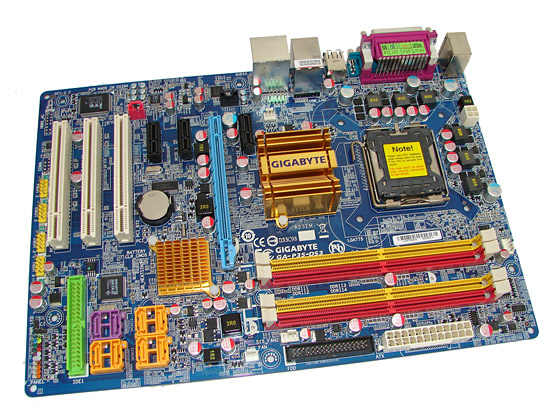
The spiritual successor to Gigabyte's highly acclaimed GA-965P-DS3 series is the new GA-P35-DS3R. The board features a single x16 PCI Express slot, two x1 PCI Express slots, and three PCI 2.2 slots. The new ICH9R chipset is also included with six SATA 3Gb/s ports, and two additional SATA 3Gb/s ports come from the now standard JMicron JMB363 chipset that also provides IDE functionality. Audio is provided by the new Realtek ALC889A chipset and the board features Gigabyte's Ultra Durable 2 technology. This technology is a combination of ferrite core choke coils, low RDS MOSFETs, and solid aluminum polymer capacitors on the board.
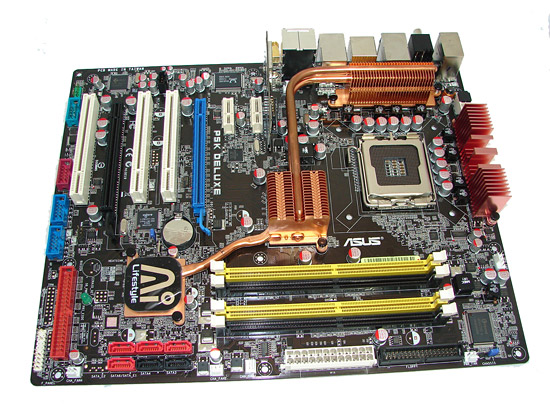
The ASUS P5K Deluxe is based on the P35 and ICH9R chipsets. The board features two x16 PCI Express slots (x16 electrical and x4 electrical for CrossFire), two x1 PCI Express slots, and three PCI 2.2 slots. The ICH9R Southbridge features six Serial ATA 3Gb/s ports with RAID 0, 1, 5, and 10 support. ASUS also supplies the JMicron JMB363 SATA controller that provides two e-SATA ports and the single IDE connector. The board is equipped with an ADI 1988B 8-channel HD audio codec and features dual Gigabit LAN. The ASUS WiFi-AP Solo IEEE 802.11g wireless card is included as is IEEE 1394a support from the Agere FW322 chipset.
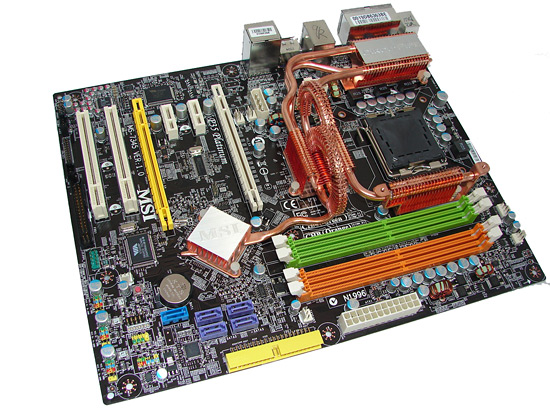
The MSI P35 Platinum is also based on the P35 and ICH9R chipsets. The board features two x16 PCI Express slots (x16 electrical and x4 electrical for CrossFire), two x1 PCI Express slots, and two PCI 2.2 slots. The ICH9R Southbridge features six Serial ATA 3Gb/s ports with MSI utilizing two for e-SATA duties. MSI utilizes the Marvell 88SE6111 chipset that provides a single 3Gb/s SATA and IDE ATA133 port on the board. The board is equipped with the new Realtek ALC888T 8-channel HD audio codec that features support for VoIP. The board features a single Gigabit LAN port and IEEE 1394a support from the VIA VT6308 chipset.
AMD uATX
We have several uATX boards featuring the AM2 processor series that we will present in our upcoming roundup that can only be described at this time as an editor killing review. The products we will briefly cover today are just a few examples of the boards that will be included. While most of our boards are based on the AMD 690G and NVIDIA 6150 technology we do have a couple of AMD/ATI RS485 boards along with a VIA K8M890 based board. We will also include results from the new NVIDIA 7050 chipset.
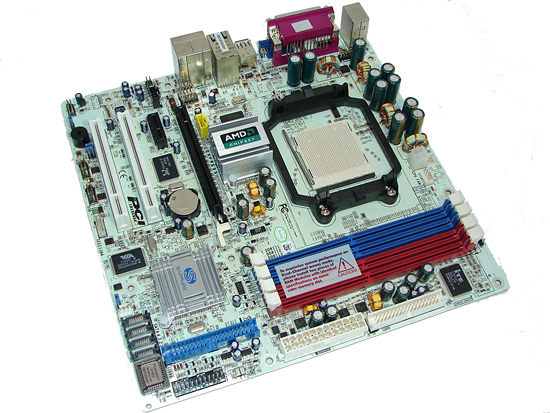
The Sapphire PI-AM2RS690MHD board is based on the AMD690G chipset that offers very good onboard video performance via the ATI X1250 with the ability to upgrade to the latest graphics card technology via the x16 PCI Express slot. The board supports 8GB of DDR2 memory, single x1 PCI Express slot, two PCI 2.2 slots, HD audio via the Realtek ALC882D, and IEEE 1394a from the VIA VT6306 chipset. The board also features HDMI, VGA, and DVI output along with four 3Gb/s SATA ports and a single IDE connector via the tried and true SB600 Southbridge. With the latest BIOS we are now over 300HTT in our overclocking tests along with the board performing superbly overall.
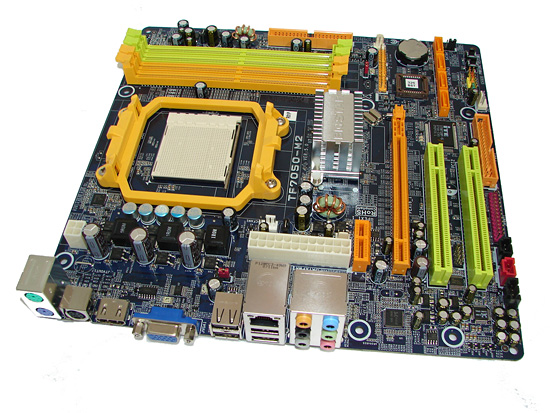
The Biostar TF7050-M2 board is based upon the new NVIDIA GeForce 7050PV and nForce 630A chipsets that offer very good system performance in a uATX form factor. The board has one x16 PCI Express slot, one x1 PCI Express slot, and two PCI slots. The board supports 4GB of DDR2 memory, HD audio via the Realtek ALC888, Gigabit LAN via the Realtek RTL-8111B Fast Ethernet, and four Serial ATA 3Gb/s ports along with a single ATA133 IDE connector. The board also features VGA and HDMI outputs. Additional details about this chipset will be available on May 15th.
We cannot disclose performance results yet for the Bearlake motherboards nor give general indications on how it compares to the P965 but all will be revealed on May 21st. Let's just say we were surprised with our test results over the last few weeks. (You'll have to wait to find out if we were surprised in a good or a bad way.) In the meantime we have three boards from ASUS, Gigabyte, and MSI to show you today with more coming shortly.

The spiritual successor to Gigabyte's highly acclaimed GA-965P-DS3 series is the new GA-P35-DS3R. The board features a single x16 PCI Express slot, two x1 PCI Express slots, and three PCI 2.2 slots. The new ICH9R chipset is also included with six SATA 3Gb/s ports, and two additional SATA 3Gb/s ports come from the now standard JMicron JMB363 chipset that also provides IDE functionality. Audio is provided by the new Realtek ALC889A chipset and the board features Gigabyte's Ultra Durable 2 technology. This technology is a combination of ferrite core choke coils, low RDS MOSFETs, and solid aluminum polymer capacitors on the board.

The ASUS P5K Deluxe is based on the P35 and ICH9R chipsets. The board features two x16 PCI Express slots (x16 electrical and x4 electrical for CrossFire), two x1 PCI Express slots, and three PCI 2.2 slots. The ICH9R Southbridge features six Serial ATA 3Gb/s ports with RAID 0, 1, 5, and 10 support. ASUS also supplies the JMicron JMB363 SATA controller that provides two e-SATA ports and the single IDE connector. The board is equipped with an ADI 1988B 8-channel HD audio codec and features dual Gigabit LAN. The ASUS WiFi-AP Solo IEEE 802.11g wireless card is included as is IEEE 1394a support from the Agere FW322 chipset.

The MSI P35 Platinum is also based on the P35 and ICH9R chipsets. The board features two x16 PCI Express slots (x16 electrical and x4 electrical for CrossFire), two x1 PCI Express slots, and two PCI 2.2 slots. The ICH9R Southbridge features six Serial ATA 3Gb/s ports with MSI utilizing two for e-SATA duties. MSI utilizes the Marvell 88SE6111 chipset that provides a single 3Gb/s SATA and IDE ATA133 port on the board. The board is equipped with the new Realtek ALC888T 8-channel HD audio codec that features support for VoIP. The board features a single Gigabit LAN port and IEEE 1394a support from the VIA VT6308 chipset.
AMD uATX
We have several uATX boards featuring the AM2 processor series that we will present in our upcoming roundup that can only be described at this time as an editor killing review. The products we will briefly cover today are just a few examples of the boards that will be included. While most of our boards are based on the AMD 690G and NVIDIA 6150 technology we do have a couple of AMD/ATI RS485 boards along with a VIA K8M890 based board. We will also include results from the new NVIDIA 7050 chipset.

The Sapphire PI-AM2RS690MHD board is based on the AMD690G chipset that offers very good onboard video performance via the ATI X1250 with the ability to upgrade to the latest graphics card technology via the x16 PCI Express slot. The board supports 8GB of DDR2 memory, single x1 PCI Express slot, two PCI 2.2 slots, HD audio via the Realtek ALC882D, and IEEE 1394a from the VIA VT6306 chipset. The board also features HDMI, VGA, and DVI output along with four 3Gb/s SATA ports and a single IDE connector via the tried and true SB600 Southbridge. With the latest BIOS we are now over 300HTT in our overclocking tests along with the board performing superbly overall.

The Biostar TF7050-M2 board is based upon the new NVIDIA GeForce 7050PV and nForce 630A chipsets that offer very good system performance in a uATX form factor. The board has one x16 PCI Express slot, one x1 PCI Express slot, and two PCI slots. The board supports 4GB of DDR2 memory, HD audio via the Realtek ALC888, Gigabit LAN via the Realtek RTL-8111B Fast Ethernet, and four Serial ATA 3Gb/s ports along with a single ATA133 IDE connector. The board also features VGA and HDMI outputs. Additional details about this chipset will be available on May 15th.










33 Comments
View All Comments
michal1980 - Thursday, May 3, 2007 - link
what was the point of posting this. to spit in our faces or something?'We know something you don't, nanananananana'
thats all I hear from this article.
should have just waited until you could have said something that was more usefull then a press release from a company.
plus over at hardforums, they are saying the p35 were moved up 2 weeks from may 21st to like the 7th.
xsilver - Thursday, May 3, 2007 - link
and why are you posting here?"I'm the biggest whinger here,,, nannanannana" ???
1) AT tries to pride themselves on being the best tech site out their, hence they usually need extra time to post articles or get very little sleep (anand/wes/derek/gary can probably speak for themselves)
2) In order to stay "bleeding edge" some "preview" articles may need to be written so that AT doesnt appear to be last on the bandwagon.
satisfied?
on a more pleasant note can anyone confirm whether this launch date of the 7th/21st is going to be a hardlaunch and some indications of what prices are going to be?
what about ddr3 availability?
Wesley Fink - Thursday, May 3, 2007 - link
According to Intel, the 7th is an OEM "stocking" date and the NDA lifts on the 21st. In fact Intel has not yet sampled their own versions of the Bearlake boards and the 21st NDA applies to people like Asus/Gigabyte/ECS/MSI/Abit/DFI/etc.yacoub - Thursday, May 3, 2007 - link
Dude, just use "whiner" like normal people. "whinger" looks so smarmy and a bit too much like Winger. =Pmichal1980 - Thursday, May 3, 2007 - link
bleeding edge does not = press release.or wait, is every site just a shile for the companies making the product.
At least label it as such. 'non paid ad for companies xyz'.
And they threw that line in about performance them selves.
Thats where the nannannana comes from.
"Surprising .. performance.. results... can not saying anything ethier way, or hint"
NANNANNAANA We know stuff.
Boushh - Thursday, May 3, 2007 - link
Besides the normal test you do, could you also check if coolers like the Thermalright Ultra 120 fit on the motherboards ? I think that many people that fit after market cooling solutions are interested in this information. Specially the MSI P35 Platinum has some odd looking contraptions in the CPU area...Besides that I'm still disapointed that so many manufactures have such a poor layout of the expansion slots. Specially the PCI slots. I personally need a minimum of two. And I also no the my gfx card will be a double slot one. I also want at least one slot between the gfx card and the other cards. That does not leave me with much options.
I'm disappointed that many manufactures are going for dual gfx solutions whil I recon that only a few people actualy make use of it. The dual PCIe slots eat up room. And many boards that do have a decent layout miss extra features (many current P965 boards with a decent layout miss the ICH8R). Some how people that want all the options but no dual PCIe slots messing up the layout are left in the dark.
Maybe something you could mention to the manufactures ?
Stele - Thursday, May 3, 2007 - link
Actually it's more of marketing hype - making mountains out of molehills as is unfortunately often the case with some manufacturers, who try to capitalise on the fact that your average PC buyer is not electronically-inclined.
Choke coils on motherboards, for example, have generally be wound on ferrite cores for the longest time! Same goes for 'low RDS MOSFETs'... by the way, it should be 'low RDS(ON) MOSFETs', which means MOSFETs with low Resistance, between their Drain and Source, when they are in the 'ON' state (i.e. when current is flowing through them). This allows minimum obstruction to current flow, which translates into higher efficiency and lower power dissipation (the higher the resistance, the more power is lost as heat). Again, MOSFETs with low RDS(ON) have been pretty much standard on decent motherboards for some time now... the difference is that top manufacturers use MOSFETs with very low RDS(ON), which are of course better but cost more.
As such, these claims are about as big a deal as saying that the new motherboards feature onboard 10/100Mbps NICs and onboard audio....
To be fair, Gigabyte probably meant that they're using higher-quality ferrite-core coils, and especially-low RDS(ON) MOSFETs. However, from experience, it'd most likely turn out that the components they use aren't super-outstanding as their marketing hype makes it out to be.
TA152H - Thursday, May 3, 2007 - link
Gary,There is a slight contradiction in your article. On one hand you mention how people should be interested in the motherboards you're testing based on the old chipsets, and then you mention how surprising the P35 (they are beginning to sound like fighter planes!) was for you. Hmmmm, if you were buying and you read something like that, how inclined would you be to buy the current stuff? Agreed, most people don't need the latest and greatest, but with a motherboard it's often worth it because of the technologies it supports. It's not at all clear the P35 will be expensive, at least I've heard nothing about that (maybe you know the prices better though), although it is very clear the performance is outrageous, particularly paired with DDR3. I wouldn't even consider a P965 anymore, and never would consider that rubbish NVIDIA sells at all. I think most people, particularly people reading this site, are going to feel the same way. DDR2 was a crappy technology, but from all indications DDR3 is a pretty good one, and it's becoming common knowledge the P35 is going to be the next "BX". It's worth waiting a few weeks. But then again, outside of companies like Intel and Supermicro (and even with them, to some extent) you take a risk when something new is introduced. So, that's something positive for the older stuff; you can buy stuff from second rate companies like Asus and Gigabyte and they'll probably be pretty stable by now. Buying a P35 from them would entail a lot more risk, so I guess there should still be interest in the P965, particularly since Intel and Supermicro can be quite expensive, and generally do not have the best performance.
ss284 - Thursday, May 3, 2007 - link
There have been plenty of performance reviews of the bearlake platform. Most of your post is pretty much useless.http://www.tweaktown.com/articles/1062/1/page_1_p3...">http://www.tweaktown.com/articles/1062/...earlake_...
Xtremesystems forum also has some ddr-3 testing.
The point is, performance wise bearlake will make little to no difference. Maybe 2-3% at most. ddr-3 performance suffers from high latencies and poor initial performance, much like ddr-2 when it came out. The chipset itself will be more expensive than the p965, which isn't exactly cheap right now.
TA152H - Thursday, May 3, 2007 - link
Are you crazy? So far no chipset has been able to show broad superiority over the P965, not anything from NVIDIA, or even the 975. They win at some, and lose at others. Now you see a preproduction motherboard, that is far from running optimally, and it's already outperforming it in every way! No, that's not impressive. Even with final silicon, you see improvements in performance just from changes in the BIOS, so to beat a mature design so early on is very, very impressive. When the intial boards come in, the difference will be pretty startling, unless you really have no perspective. Also keep in mind that improving performance on something with a 4MB cache is a lot harder than improving it on something with a 512K cache. Hopefully they'll test the Core 2 with the smaller cache here to show the memory controller differences a little better.I'm not going to go into all the technical merits of DDR3 because there are enough articles out there that do. It's what DDR2 should have been. DDR2 sucked did nothing but disappoint, and I'm still scratching my head as to why they released this half-baked technology instead of going straight to DDR3 like AMD wanted to. Then again, we saw RDRAM for the Pentium III, so weird things do happen.